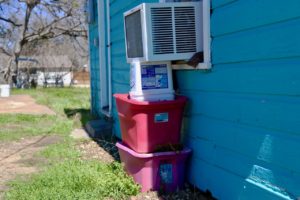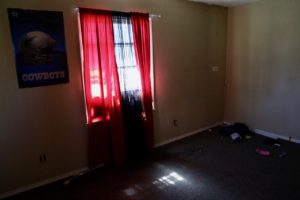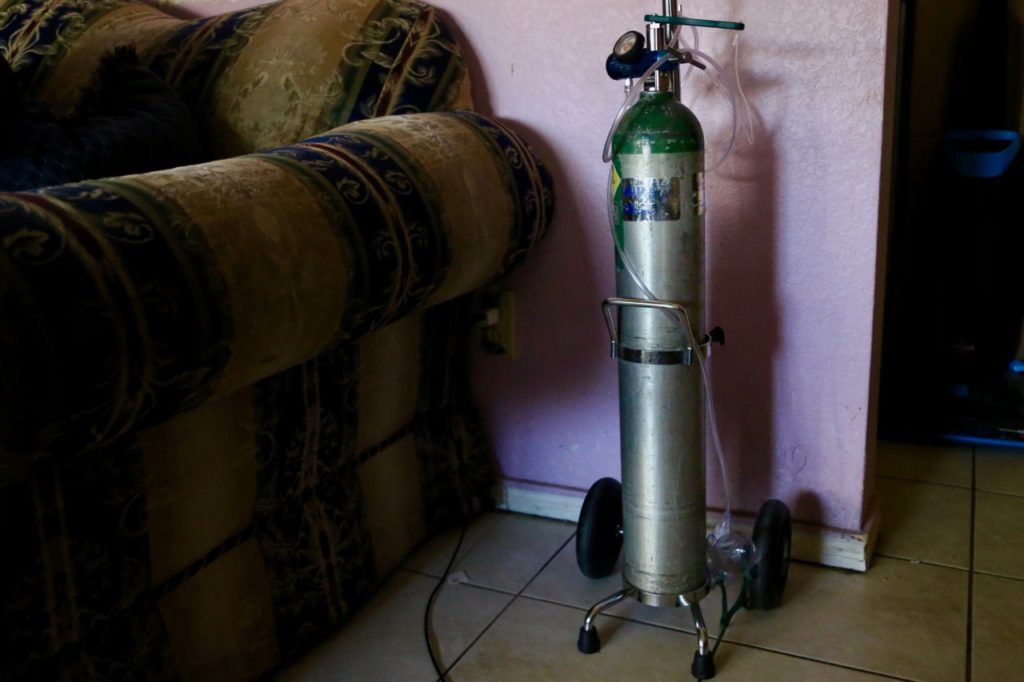700th Restoration Project Makes Grapevine Feel Like Home Again
GRAPEVINE — The muted sounds of worship music hang in the air, drifting from a wireless radio across a ten-yard stretch of grass that serves as Regina’s front yard. Her home — barely over 400 square feet in actual living space — is a swarm of activity. Volunteers surround the property; most within arm’s length of one another, many of them with paint brushes in hand. A cool spring morning evaporates into the heavy air of oncoming summer. With rain in the forecast, the team is laboring to finish repairing as much as they can before calling it a day. This is one of nearly thirty worksites under construction during the spring 2019 Community Powered Revitalization (CPR) Blitz. But it’s a special one.
Regina’s home is the 699th repaired by the program. Her mother’s, across the street, makes 700.
Built in the 1930’s, the monumental property is one of the oldest 6 Stones has ever restored. Both it and Regina’s home are designated historical landmarks in the City of Grapevine; their new paint colors had to be approved by the local historical society. Buildings from wildly different eras flank their homes: high-end, large floor plan homes on one side and minimal, traditional architecture — including the historic Love Chapel Church — on the other. It’s a different community now, but it still feels like home.
Growing Up Grapevine
Born in 1951, Regina has watched the community transform over the last few decades. Property values shot up as the construction of the DFW International Airport, a rise in local tourism, and the resulting boom in new business bolstered the economy. Even before that, political and cultural forces shaped the course of Regina’s life.
“I’m 68. I’ve been here all my life. Born, raised, reared; this is my roots. This is where [mom] has lived ever since I’ve been in the world,” Regina said. “It used to just be one totally all-black neighborhood. Just little houses like I got, like the little yellow house which they’ve restored. All the houses on this street… were just little bitty wood frame homes. Most of the people that lived here were uncles and aunties and sisters and brothers and kinfolks; it was sort of like a little community of relatives that grew up here and lived here long years ago. Most of them are gone.
“There’s probably about nine or ten of us in all that was originally here. But the rest of them are people that has bought the properties and moved in around us. They seem to be pretty good neighbors. We all get along. So I think that’s great!”
Most of America remained segregated during Regina's childhood, Grapevine included. She attended OJ Turner, an all-black elementary school, until the district de-segregated and her class merged into Grapevine Middle School. That sudden transition saved her from a long commute to the nearest middle school for children of color: I.M. Terrell in Fort Worth.
She could grow up in Grapevine, just like all the other kids who lived there.
An Unexpected Challenge
Two contradictory but compounding worlds merge in Regina's story. On the one hand, she struggled to keep up in school because of the disparity in the segregated schools that forged the foundation of her academic career. On the other, however, she saw the magnitude of civic engagement first-hand in the form of a young man who would eventually become her husband.
“I was going into ninth grade [when the schools desegregated]. We had a little three-room school. We’d know 1+1, 2+2, so it was kind of scary when we integrated and had to go to a school of all whites. The learning that we had was so much different from the teachings that they had and the books that they had,” Regina said.

Retrofitted air conditioning units on the home required more support than the window sills could provide.
“They had measurements and history, we just didn’t have all that at [our] school. We had just the minimum, normal teaching. If you were smart enough, you’d get a good education; if you went to another black school. But when we went to the white school, it was so much different. I’m ashamed to say it, but I failed that first year. We were slower than the other kids. A lot of us failed, but as the year went by, we caught on and we made it. I went from Grapevine Middle School to Grapevine High and made it out of there.”
The Boy Next Door
Even as she struggled to catch up to students with a systemic advantage over her, Regina could see her place in Grapevine. She fell in love with a boy who lived in the neighborhood and eventually married him. When her father-in-law passed away, the couple inherited the house. That’s when Regina moved into her second-ever home, across the street from her first.
“We were the Girl and Boy Next Door to each other. He used to live in a little town called Lake Village, Arkansas. That’s where he came from. I’ve always been here, he moved here when he was about eleven years old and lived with his father. He stayed here until he died. He worked on the dam over here, the Grapevine Dam… worked on the airport and stuff with his dad. You know, he drove the heavy equipment. Until they became ill and they couldn’t do the work anymore. Before he died, he were helping the community about trying to get the housing and stuff done, you know, to better the community.”
Now a widow with children, Regina began fighting the same battles her husband fought, this time on a very personal front. Her own house needed help.
Historic Home, Historic Help
Regina worked for most of her adult life before her health declined, but home ownership still presents her with a budgetary challenge. Heavy rain ruined her roof and flooded the house, making it unliveable for the time being. Both her property and her mother’s are now historic homes within the City of Grapevine, and Regina qualified for assistance with roof and foundation repairs because of that status.
But salvaging a house and making it back into a home are two different things.

After the roof gave way, Regina removed everything from her home. It still sits almost empty while volunteers restore the exterior.
For now, Regina is living with and caring for her aging mother in the house across the street; the house she grew up in. But she’s dreaming of a day when she can return to the home where she raised her own children; the place her grandchildren know as hers and hers alone. A day that’s within sight now that Grapevine benefits from Community Powered Revitalization. The program won’t be able to solve the interior problems at her house, but it will restore its structural integrity at no cost to her. That’s step one in bringing Regina home.
“I feel like sometimes that I’m still here because my mom is here. I’m not going to leave her. God forbid, but I may be gone before she do. But I love it here. I really love it here. I think I could live here the rest of my life, by myself with my neighbors. We all know each other still. We’re real good friends. With all the changes, I could still live here and be happy,” she said.
“Everybody needs help every now and then, to get up on their feet. I’m one of them that will accept help if it’s there for me. But I’m also one of those that, if it’s not there for me — and I’ve gotten used to not having — I just pray to the Good Lord, and He’s been kind of keeping me balanced out. It may not happen right then, but sooner or later, whatever I’ve asked for, it comes.”
She’s asking now. You just might be the answer.

Regina's mother did not give an interview for this article, but her presence can be clearly felt around the home.
Want to help families like Regina’s? Register as a Community Powered Revitalization volunteer or make a gift in support of the program.

